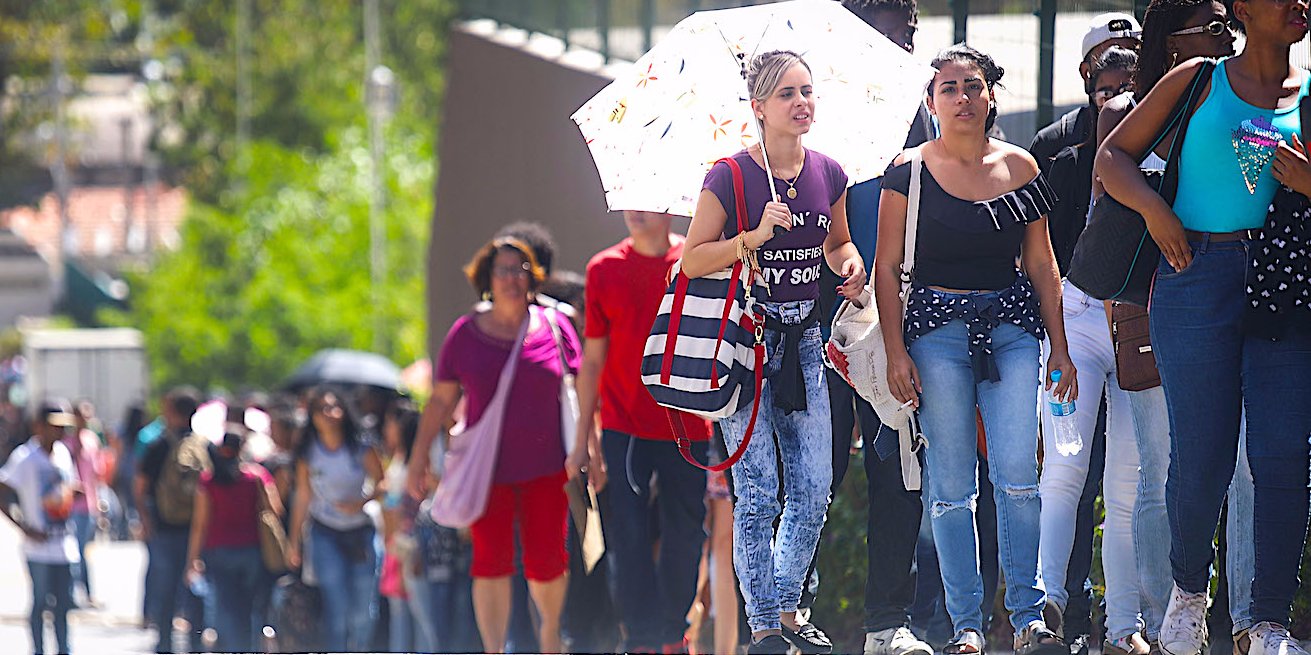 An unemployment line in Brazil.(Photo by Mario Tama/Getty Images)
An unemployment line in Brazil.(Photo by Mario Tama/Getty Images)
- The UK currently has the lowest ever-unemployment and the highest-ever minimum wage.
- Data tracking back to 2000 show no link between the wage level and unemployment.
- The minimum wage has risen faster than inflation over that time period.
- The data suggest that the traditional economic idea that rising wage prices reduce the number of available low-paid jobs might not be true.
LONDON — It’s one of the oldest and fiercest debates in economics: Does raising the minimum wage increase unemployment, by making it more expensive for employers to hire extra workers?
One way to look at the issue is to compare unemployment and minimum wage rates over time. If minimum wage rises reduce the number of jobs created, then you should be able to see a correlation between the two.
In fact, British wage and unemployment data appear to show that a doubling of the minimum wage over the last 17 years has had no obvious effect on unemployment. The UK currently has the lowest ever unemployment and the highest ever minimum wage.
Whether wages and unemployment are linked is an economic shibboleth for both left and right.
Economic conservatives believe that the greatest number of jobs will be created in an unregulated market, where the supply of labour will perfectly meet demand at any given price. Letting the market set wage prices is the most efficient way of creating the maximum number of jobs, they argue.
The tone on the right was set by the economist Milton Friedman, who in a 1966 edition of Newsweek wrote, “Congress has just acted to increase unemployment. It did so by raising the legal minimum-wage rate from $1.25 to $1.60 an hour, effective in 1968, and extending its coverage. The result will be and must be to add to the ranks of the unemployed.”
In a celebration of that essay, the American Enterprise Institute illustrated Friedman’s point with this chart, showing a rough correlation between rising minimum wages and increasing teen unemployment at the time.
Those on the left counter that the free market allows employers to pay poverty-level wages. It’s not just about low pay, either: Workers who don’t earn enough to meet their basic needs also do not have the consumer spending power that a prosperous economy needs to grow, they argue. The Great Depression of the 1930s is the classic example of that, as Waddill Catchings and William Trufant Foster argued after publishing their 1928 book “The Road to Plenty.”
The issue is complicated because wage rates and unemployment aren’t directly correlated. While the rising price of labour does have an effect on the total demand — you can’t raise it to £100 an hour — there are many other factors influencing employers when they add workers. The cost of competing forms of investment, price inflation, and the base rate of interest are among myriad other places where an employer might spend money instead of hiring.
But when you run the UK’s official minimum wage rate since the year 2000 against the unemployment rate over the same period, one thing becomes immediately obvious. There is no observable relationship between rising minimum wages and unemployment on a national level:
 ONS / Gov.uk
ONS / Gov.uk
Usually, economists try to measure the wage/unemployment effect by calculating whether a change in the wage rate is correlated with a change in the job creation rate. Many of the studies have been done in the US because the 50 different states have different minimum wage rates, creating a macroeconomic petri dish in which statisticians can look at unemployment and job creation rates for similar populations who may live next door to each other, but are divided by separate wage laws along the state lines between them.
The Federal Reserve Bank of San Francisco has a good discussion of this measurement problem here. Earlier studies at the national level have found an “elasticity” between wages and unemployment of about 0.1, meaning that a 10% increase in the minimum wage would reduce employment by 1%.
Other studies of smaller areas have found an elasticity of 0, meaning the two don’t have an effect on each other. Either way, that tradeoff suggests the benefits of raising the wage outweigh the relatively minor job losses it might create.
The chart above would certainly bear this out: The UK unemployment rate has moved up and down independently of the rise in minimum wages for nearly two decades. Currently, the minimum wage is at its highest-ever, and the UK has got the lowest-ever unemployment since the early 1970s. That wage increase has been significant: 108% since 2000, or roughly a doubling, from £3.60 to £7.50 ($4.72 to $9.83).
Interestingly, the value of the minimum wage has held up despite inflation. In other words, the chart would not look much different — and the two lines on it would not move together more often — if the wage rate was adjusted for inflation. A chart from Full Fact of the inflation-adjusted minimum wage over time, shows the wage rate increasing over time, albeit on a more gentle upward slope.
And, separately, the minimum wage has maintained its value compared to GDP, the retail price index (RPI) and the consumer price index (CPI). It has risen ahead of all of them on a nominal basis:















